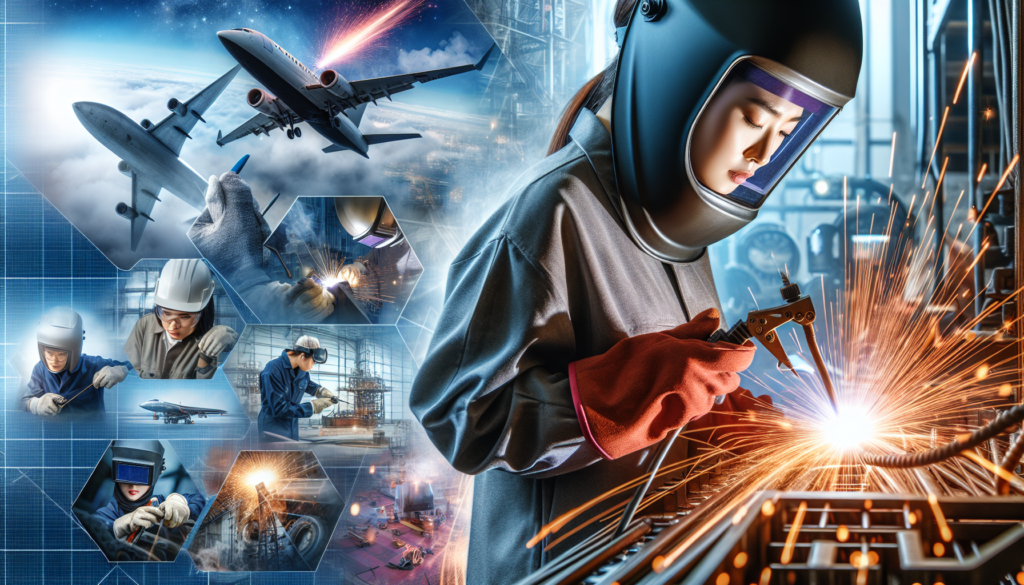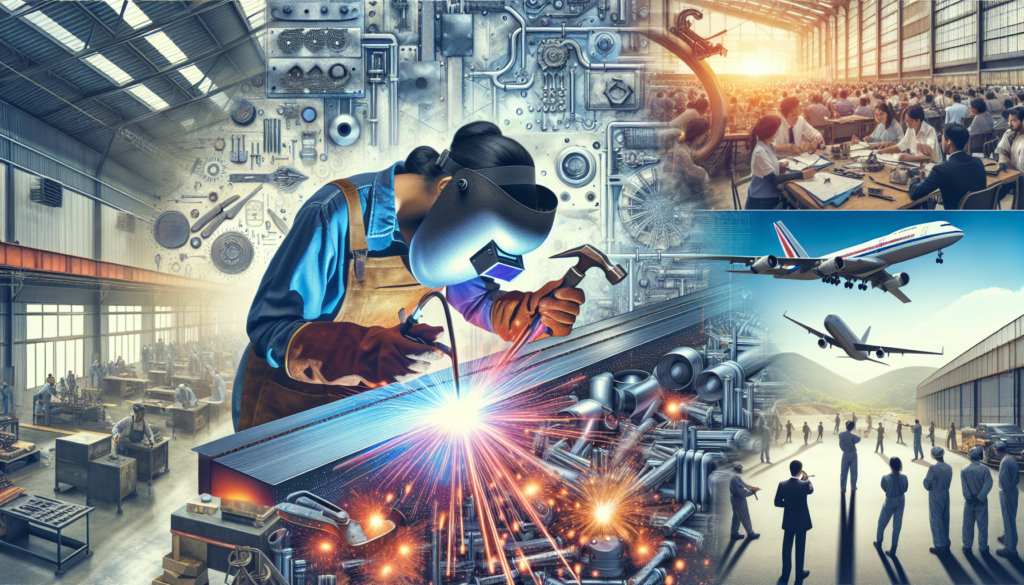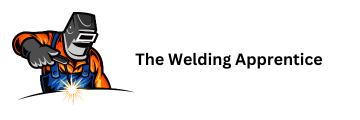Imagine a world where creativity and practical skills intertwine, resulting in the creation of masterpieces that are as strong as they are beautiful. Enter Welding J, an innovative brand that is revolutionizing the art of welding. With a focus on precision, quality, and craftsmanship, Welding J is setting new standards in the industry. Whether you’re a professional welder or a hobbyist enthusiast, their cutting-edge equipment and expert guidance will empower you to bring your visions to life. Get ready to unleash your creativity in the world of welding with Welding J.
Introduction
Welcome to the comprehensive guide to welding! In this article, we will take you on a journey through the history of welding, explore various types of welding techniques, delve into the different methods of arc and gas welding, examine resistance welding and energy beam welding, and learn about the solid-state welding process. We will also discuss the essential equipment and tools used in welding. By the end of this article, you will have a deeper understanding of this fascinating field and its impact on society.
History of Welding
Ancient Welding Techniques
Welding is not a new concept; it has been practiced for thousands of years. Ancient civilizations used various techniques to join metals together. One of the earliest known welding methods dates back to the Bronze Age, around 3000 BC. Known as forge welding, this technique involved heating metals and pounding them together to create a bond.
The Welding Renaissance
After the fall of the Roman Empire, welding techniques were largely forgotten. However, the Renaissance period sparked a resurgence of interest in welding. Inventors and craftsmen explored new methods to join metals, leading to the development of techniques such as pressure welding and resistance welding.
Industrial Revolution Impact
The Industrial Revolution was a turning point in the history of welding. The demand for stronger and more efficient structures, machinery, and transportation systems led to advancements in welding. The introduction of arc welding and gas welding techniques revolutionized the field, making it faster, more reliable, and accessible on a larger scale.

Types of Welding
Arc Welding
Arc welding is a widely used welding process that utilizes an electric arc to create a fusion between metals. This technique involves the use of a power supply, electrode, and a shielding gas or flux. There are several subtypes of arc welding, each with its own characteristics and applications.
Gas Welding
Gas welding utilizes a combination of fuel gases and oxygen to produce a flame that melts the metals being joined. This technique is commonly used in repair work and smaller-scale projects. Different gas welding processes offer varying levels of versatility and precision.
Resistance Welding
Resistance welding is a technique that relies on a combination of pressure and electrical resistance to create a weld. This method is commonly used in the automotive and construction industries due to its speed and efficiency. Spot welding, seam welding, and projection welding are the three main types of resistance welding.
Energy Beam Welding
Energy beam welding utilizes high-energy beams, such as lasers or electrons, to heat and join the metals together. This method allows for precise control and is often used in industries requiring high precision and clean welds.
Solid-state Welding
Solid-state welding involves directly joining metals without the use of heat or melting. Instead, pressure and mechanical actions are used to create a bond between the materials. Friction welding, ultrasonic welding, and explosion welding are some examples of solid-state welding techniques.
Arc Welding
Shielded Metal Arc Welding (SMAW)
Shielded Metal Arc Welding, also known as stick welding, is one of the most widely used arc welding techniques. It involves the use of a consumable electrode coated with a flux that provides shielding and helps create a stable arc. SMAW is versatile and can be used in various industries and applications.
Gas Metal Arc Welding (GMAW)
Gas Metal Arc Welding, commonly known as MIG welding, utilizes a wire electrode and a shielding gas to create a weld. GMAW is known for its high welding speed and is often used in industries such as automotive manufacturing, construction, and metal fabrication.
Flux-Cored Arc Welding (FCAW)
Flux-Cored Arc Welding is similar to GMAW, but instead of using a solid wire electrode, it uses a tubular electrode filled with flux. FCAW is commonly used in outdoor welding applications and is known for its high deposition rates.
Submerged Arc Welding (SAW)
Submerged Arc Welding is a technique that involves the formation of a weld under a layer of granular flux. This method provides excellent weld quality and is often used in applications requiring high productivity and large welds.
Plasma Arc Welding (PAW)
Plasma Arc Welding utilizes a highly concentrated and intense arc produced through a plasma gas. This method offers superior control and precision, making it suitable for welding thin materials and intricate designs.

Gas Welding
Oxyfuel Gas Welding (OFW)
Oxyfuel Gas Welding utilizes different fuel gases, such as acetylene or propane, combined with oxygen to create a welding flame. This technique is commonly used for welding and cutting applications in metal fabrication, repair work, and jewelry making.
Oxyacetylene Welding (OAW)
Oxyacetylene Welding, often referred to as oxy welding, is a specific type of gas welding that uses acetylene and oxygen to create a flame for welding. It is versatile and can be used on various metals, making it popular for automotive repairs, plumbing work, and sculpture fabrication.
Oxyhydrogen Welding (OHW)
Oxyhydrogen Welding, also known as water welding, utilizes hydrogen and oxygen gases to create a flame for welding. This method is primarily used for precision welding, particularly in the jewelry and electronics industries.
Resistance Welding
Spot Welding
Spot Welding is a resistance welding technique that involves applying pressure and electrical current to create a weld at specific points. This method is commonly used in the automotive industry for joining sheet metal panels together.
Seam Welding
Seam Welding is another form of resistance welding where continuous welds are created along the length of overlapping or abutting metals. It is often used in the manufacturing of pipes, cans, and containers.
Projection Welding
Projection Welding is a resistance welding technique that utilizes raised projections on one or both metals being joined. The projections concentrate the heat and pressure, creating localized fusion. Projection welding is frequently used in the automotive and electrical industries.
Energy Beam Welding
Lasers
Laser Welding utilizes a focused laser beam to create a small, precise weld. This method offers high accuracy and is commonly used in industries such as electronics, aerospace, and medical device manufacturing.
Electron Beam
Electron Beam Welding uses a highly focused beam of electrons to generate heat and create a weld. This technique is particularly useful in industries requiring deep penetration and high-quality welds, such as aerospace and nuclear power.
Solid-state Welding
Friction Welding
Friction Welding involves rubbing and rotating two metal components together until friction generates enough heat to create a weld. This method offers high strength and joining efficiency, making it suitable for applications in the automotive and aerospace industries.
Ultrasonic Welding
Ultrasonic Welding utilizes high-frequency vibrations to create friction and heat between two metals, causing them to join together. This technique is commonly used in industries such as electronics, packaging, and medical device manufacturing.
Explosion Welding
Explosion Welding involves the controlled detonation of explosives between two metal plates, creating a weld at the interface. This technique is primarily used for joining dissimilar metals and is often utilized in industries such as shipbuilding and oil and gas.
Welding Equipment and Tools
Welding Machines
Welding Machines are the primary equipment used in welding, providing the power and control needed to create the desired weld. Different types of welding machines are available, corresponding to the specific welding technique being used.
Welding Helmets
Welding Helmets are essential safety equipment that protects the welder’s face and eyes from harmful sparks, radiation, and debris. Modern welding helmets often feature adjustable shades, allowing welders to customize the level of protection depending on the task at hand.
Welding Electrodes
Welding Electrodes are consumable rods or wires that serve as the filler material during the welding process. Different types of electrodes are used depending on the welding technique and the metals being joined.
Welding Rods
Welding Rods are similar to welding electrodes but are typically used in stick welding. These rods are coated with a flux, which provides shielding and helps create a stable arc.
Gas Cylinders
Gas Cylinders store the gases required for gas welding processes, such as acetylene and oxygen. These cylinders must be handled and stored with care to ensure safety.
Conclusion
Welding has come a long way throughout history, from ancient techniques to cutting-edge processes. It has played a significant role in shaping the world around us, enabling the construction of remarkable structures, producing essential machinery, and advancing various industries. Whether it’s arc welding, gas welding, resistance welding, energy beam welding, or solid-state welding, each technique has its unique applications and benefits. By understanding the different types of welding, equipment, and tools, we gain a deeper appreciation for the skill and innovation that goes into the welding process. So, the next time you see a well-crafted weld, you can marvel at the centuries of history and progress behind it. Happy welding!
